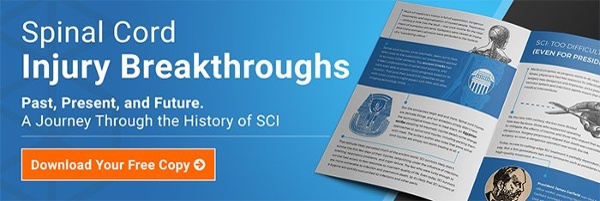Is Blood Pressure an Important Factor in Spinal Cord Injury Recovery?
There are a variety of factors that come into play when it comes to spinal cord injury recovery — everything from early medical intervention and treatment, relieving of pressure on the spinal cord, intensive physical therapy, and medication management. However, one of the most critical functions of SCI recovery is the monitoring and management of spinal cord injury blood pressure.
This article will cover how the spinal cord itself affects blood pressure, how spinal cord injury blood pressure affects spinal cord injury recovery, and it will explore a new form of spinal cord injury treatment that is being used to facilitate improved prognosis of spinal cord injury recovery in patients.
Blood Pressure Plays a Role in Spinal Cord Injury Recovery
How the Spinal Cord Affects Blood Pressure Levels
The spinal cord is an integral part of the body’s central nervous system (CNS). In addition to serving as the communication conduit for the body and brain, it also is responsible for regulating blood pressure in the body. When the spinal cord is injured, the body may not be able to regulate or maintain the appropriate blood pressure, either increasing or decreasing to dangerous levels.
A person’s blood pressure measurement is based on two key factors: 1) their physical activity, and 2) elasticity of the blood vessels to expand or contract. Because a spinal cord injury impedes brain signals from reaching areas of the body below the injury site, it means that the heart and blood vessels may not receive the message about adjusting their pressure or constriction to force more or less blood to the brain. These issues can cause extreme changes in spinal cord injury blood pressure that can affect spinal cord injury recovery.
Any injury of the spinal cord may result in a condition known as autonomic dysreflexia (AD). This condition, in the most basic terms, is a form of life-threatening hypertension (high blood pressure) that can lead to hospitalization for spinal cord injury survivors. It is the body’s response to painful or uncomfortable stimuli, meaning that constipation or even an ingrown toenail may trigger the body’s nervous system to respond and go into overdrive, elevating blood pressure to dangerous levels.
Optimal blood pressure for a healthy person without a spinal cord injury is considered 130/80 mmHg (which stands for millimeters of mercury) — previously 140/90 mm Hg — for systolic and diastolic blood pressure measurements, respectively. According to the Christopher & Dana Reeve Foundation, an adult with a T6 or higher SCI has a normal systolic blood pressure between 90-110 mmHg. Autonomic dysreflexia can cause systolic blood pressure readings to increase by 20-40 mmHg.
According to Web MD, this condition couples dangerously high blood pressure with decreased heart rates. It can make achieving optimal spinal cord injury recovery more difficult for patients, as it may limit their ability to engage in any rigorous physical activity. AD most commonly affects SCI survivors with a T6 injury or higher; however, in rare cases, it also can affect those with lower level injuries as well.
Some SCI survivors run into the opposite issue; they experience orthostatic hypotension (OH), a form of chronic low blood pressure that can lead to fainting multiple times a day or unable to do many activities. Much like hypertension, low blood pressure can also potentially impede spinal cord injury recovery. It typically occurs when someone tries to move upright after lying or sitting down.
How Spinal Cord Injury Blood Pressure Affects Recovery
When a spinal cord injury affects the autonomic nervous system, it can elevate or reduce blood pressure to dangerous levels that can affect basic function. When left untreated, autonomic dysreflexia can result in a variety of symptoms, including:
- Stroke,
- Cardiac arrest,
- Seizure,
- Pulmonary edema,
- Retinal hemorrhage,
- Cerebral hemorrhage, and
- Death.
Orthostatic hypotension, which occurs when blood pools in the lower body — specifically the legs and abdomen — can lead to a variety of debilitating symptoms, including:
- Bouts of dizziness,
- Lightheadedness,
- Blurred vision,
- Nausea,
- Syncope (fainting).
Spinal Cord Injury Blood Pressure Regulation and Management
A new protocol is being used at Zuckerberg San Francisco General Hospital (ZSFG) and Trauma Unit and is changing the prognosis of spinal cord injury and is helping more spinal cord injury survivors get back on their feet. According to an article in MedicalXpress.com, the procedure “is a mixture of revised evaluations and new treatments to personalize care” that spurs faster recoveries.
Everyone has a unique spinal cord injury blood pressure and blood flow; it’s a matter of getting it to the optimal point that minimizes potential harm and enhances spinal cord injury recovery.
The article states that one of the most critical factors of the new treatment protocol at ZSFG is figuring out each person’s optimal blood pressure and getting them in the operating room as soon as possible. Unlike conventional approaches to spinal cord injury recovery, this method would have SCI survivors in surgery within the first 12 hours of when an injury occurs and immediately implementing aggressive SCI pressure management.
Another form of recovery concerning spinal cord injury blood pressure and cardiovascular function comes in the form of spinal cord epidural stimulation (ES). One study has shown an enduring effect from epidural stimulation on orthostatic hypotension, helping to stabilize blood pressure and heart rate between ES sessions.
To learn more about spinal cord injury recovery treatments and research, be sure to check out our complimentary resource by clicking on the link below. Contact us today with any questions about spinal cord injuries or to speak with a spinal cord injury lawyer.
Stay Updated on Advancements On Traumatic Brain &
Spinal Cord Injuries
About the Author





